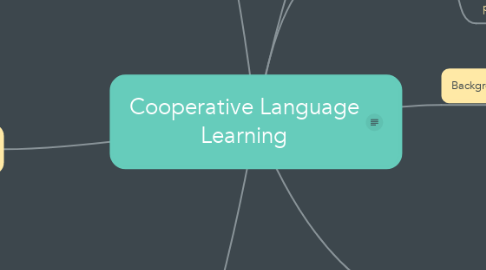Cooperative Language Learning
by Leslie Avilés

1. Roles
1.1. ROLE TEACHER
1.1.1. The teacher has two main roles: the first role is to facilitate the communica-tion process between all participants in the classroom, and between these par-ticipants and the various activities and texts. The second role is to act as anindependent participant within the learning-teaching group.
1.2. ROLE STUDENT
1.2.1. The role of learner as negotiator
1.3. Instructional Materials
1.3.1. We will consider three kinds of materials currently used in CLT and label thesetext-based, task-based, and realia.
2. Design
2.1. OBJECTIVE
2.1.1. Curriculum orinstructional objectives for a particular course would reflect specific as-pects of communicative competence according to the learner’s profi-ciency level and communicative needs.
2.2. SYLLABUS
2.2.1. syllabus models continues in the CLT literature, somehave argued that the syllabus concept be abolished altogether in its ac-cepted forms, arguing that only learners can be fully aware of their ownneeds, communicational resources, and desired learning pace and path,and that each learner must create a personal, albeit implicit, syllabus aspart of learning.
2.3. TYPES OF LEARNING AND TEACHING ACTIVITIES
2.3.1. The range of exercise types and activities compatible with a communica-tive approach is unlimited, provided that such exercises enable learners toattain the communicative objectives of the curriculum, engage learners incommunication, and require the use of such communicative processes asinformation sharing, negotiation of meaning, and interaction. Classroomactivities are often designed to focus on completing tasks that are medi-ated through language or involve negotiation of information and infor-mation sharing.
3. Procedure
3.1. CLT classroom procedures (e.g., group activities, languagegames, role plays), but neither these activities nor the ways in which theyare used are exclusive to CLT classrooms. Finocchiaro and Brumfit offer alesson outline for teaching the function “making a suggestion” forlearners in the beginning level of a secondary school program that sug-gests that CLT procedures are evolutionary rather than revolutionary
4. Theory of language CLT The Communicative Approach in language teaching starts from a theoryof language as communication. The goal of language teaching is todevelop what Hymes (1972) referred to as “communicative compe-tence.” Hymes coined this term in order to contrast a communicativeview of language and Chomsky’s theory of competence
5. Background
5.1. CLT was taught by practicing basic structures in meaningful situation-based activities
6. Approach
6.1. Theory of learning Learning activities are consequently selected according tohow well they engage the learner in meaningful and authentic languageuse (rather than merely mechanical practice of language patterns).
7. Conclusions
7.1. Communicative Language Teaching is best considered an approachrather than a method. It refers to a diverse set of principles that reflect acommunicative view of language and language learning and that can beused to support a wide variety of classroom procedures.These principles include:– Learners learn a language through using it to communicate.– Authentic and meaningful communication should be the goal of class-room activities.– Fluency is an important dimension of communication.– Communication involves the integration of different language skills.– Learning is a process of creative construction and involves trial anderror.

